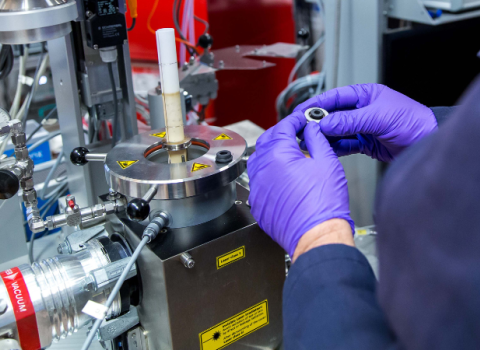Annual survey of 2,000 companies finds the bloc dominates automotive R&D, but lags in pharmaceuticals, software and computer hardware

Simulation of car manufacturing by robots on Siemens stand at Messe fair in Hannover. Photo credits: prescott09 / BigStock
The EU’s private R&D spending spiked by 9.8% last year, outstripping growth in the US, and for the first time in a decade, China, according to the annual Industrial R&D Investment Scoreboard of the world’s 2,000 top-spending companies, a group that together accounts for the vast majority of global research.
The good news for the EU is that in 2023 and 2022, private R&D spending grew strongly after a weak year in 2021 and an unprecedented fall in 2020, during the COVID-19 pandemic.
“This year, EU-based companies have surpassed their global counterparts in R&D growth for the first time in over a decade, a testament to Europe's potential for innovation,” said Ekaterina Zaharieva, new commissioner for start-ups, research and innovation, in a forward to the report.
The EU 9.8% growth spurt outpaced the US (5.9%) and China (9.6%). But the US’s overall spending of €531.8 billion is still more than double the EU total. And when China’s deflation is taken into account, its R&D spending growth is in real terms much higher than in the EU.
There are plenty of other details in the report – both concerning and encouraging – for EU companies to mull over. Here, Science|Business picks out six of the most important charts.
EU still just ahead of China

Big investments by European car companies, and slower growth in China, mean that the bloc still just about spends more on R&D. After years of suffering a declining share of world R&D, “the previous downward trend,” in the EU has ended.
However, the report notes that some of this is due to a change in methodology. This year’s scoreboard surveys 2,000 companies, compared to 2,500 in previous years. There are more European companies at the higher end of the ranking, so the change has cut out more Chinese firms than European.
“Consequently, the small lead of EU companies over Chinese counterparts should be interpreted with caution, as a more extensive sample would reverse this pattern,” the report says.
Meanwhile, the US’s global lead in private R&D spending shows no sign of diminishing, despite its overall economy shrinking relative to the rest of the world.
EU R&D spending has been weak

In her foreword to the report, Zaharieva hailed the EU for growing its R&D spending more quickly than the US or China.
But that’s only this year, as the chart above makes clear. The report cautions that “over the past 10 years, R&D investment by the EU Scoreboard companies has been growing more slowly than that of US and Chinese Scoreboard companies.”
In other words, impressive growth in EU R&D spending last year is only in the context of a disastrous pandemic period, when in 2020-21 R&D spending all but stagnated.
EU remains car king

Of the big four R&D heavy industries – IT hardware, software, health and automotive – the EU only dominates the latter.
The report describes the automotive sector as the EU’s “stronghold”, with companies investing twice as much in car R&D as US and Japanese rivals, and three times as much as Chinese counterparts.
But this continued R&D lead is cold comfort to the European car industry, which is facing a crisis as China has leapfrogged the bloc as a manufacturer of electric vehicles. Threatened tariffs from a new Donald Trump-led US administration could deal a further blow to the industry.
And Chinese car firms are upping their R&D spend. Shenzhen-based BYD doubled its spending in 2023 to €4.6 billion, closing in on BMW, which spent €7.6 billion.
US tech firms dominate

A glance at the world’s top R&D spenders makes the EU’s car-dependency even more stark: it shows a handful of mainly German car companies isolated in a sea of US tech, computing hardware and pharmaceutical companies.
European, if not EU, pharmaceutical companies are world leading R&D spenders. Switzerland boasts two in the top 25 (Roche and Novartis) and the UK one (AstraZeneca).
There’s one big caveat to this chart: the report excludes US tech giant Amazon from its working because it doesn’t report R&D in a comparable way to other firms. However, “even our conservative estimates point to Amazon being the top R&D performer in the world,” it says.
German powerhouse

The report also dives deeper into R&D spending in the EU, looking at the top 800 countries across the bloc.
The main takeaway is that Germany dominates investment – far beyond what its broader economic size would suggest – largely due to its very R&D intensive car companies.
Overall, 2023 was “very positive” in Germany, the report says, with Volkswagen, Mercedes-Benz, Robert Bosch, Biontech, Carl Zeiss, Boehringer Sohn and Siemens all increasing spending by double digit percentages.
Taken together, Germany, France and the Netherlands account for nearly three-quarters of all private R&D spending, the report notes.
Rise and fall

The report looks at how the biggest national spenders in the EU have changed over the past two decades.
Some once mighty players, such as the Netherlands’ Philips, have dropped out of contention, while others, like the semiconductor manufacturing equipment producer ASML, have taken its place.
But overall, it shows how the EU’s biggest R&D players are increasingly car manufacturers.





 A unique international forum for public research organisations and companies to connect their external engagement with strategic interests around their R&D system.
A unique international forum for public research organisations and companies to connect their external engagement with strategic interests around their R&D system.